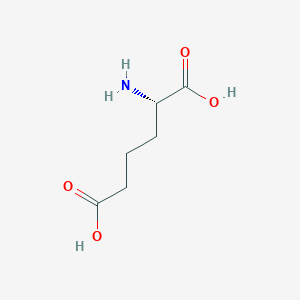|
Aminoadipic acid (CAS: 542-32-5), also known as 2-aminoadipate, is a metabolite in the principal biochemical pathway of lysine. It is an intermediate in the metabolism (i.e. breakdown or degradation) of lysine and saccharopine. It antagonizes neuroexcitatory activity modulated by the glutamate receptor N-methyl-D-aspartate (NMDA). Aminoadipic acid has also been shown to inhibit the production of kynurenic acid, a broad spectrum excitatory amino acid receptor antagonist, in brain tissue slices. Recent studies have shown that aminoadipic acid is elevated in prostate biopsy tissues from prostate cancer patients. Mutations in DHTKD1 (dehydrogenase E1 and transketolase domain-containing protein 1) have been shown to cause human 2-aminoadipic aciduria and 2-oxoadipic aciduria via impaired decarboxylation of 2-oxoadipate to glutaryl-CoA, which is the last step in the lysine degradation pathway. Aging, diabetes, sepsis, and renal failure are known to catalyze the oxidation of lysyl residues to form 2-aminoadipic acid in human skin collagen and potentially other tissues. Proteolytic breakdown of these tissues can lead to the release of free 2-aminoadipic acid. Studies in rats indicate that aminoadipic acid (along with the three branched-chain amino acids: leucine, valine, and isoleucine) levels are elevated in the pre-diabetic phase and so aminoadipic acid may serve as a predictive biomarker for the development of diabetes. Long-term hyperglycemia of endothelial cells can also lead to elevated levels of aminoadipate which is thought to be a sign of lysine breakdown through oxidative stress and reactive oxygen species (ROS). 2-Aminoadipate is a potential small-molecule marker of oxidative stress. Therefore, depending on the circumstances aminoadipic acid can act as an acidogen, a diabetogen, an atherogen, and a metabotoxin. An acidogen is an acidic compound that induces acidosis, which has multiple adverse effects on many organ systems. A diabetogen is a compound that can lead to type 2 diabetes. An atherogen is a compound that leads to atherosclerosis and cardiovascular disease. A metabotoxin is an endogenously produced metabolite that causes adverse health effects at chronically high levels. Chronically high levels of aminoadipic acid are associated with at least two inborn errors of metabolism including 2-aminoadipic aciduria and 2-oxoadipic aciduria. Aminoadipic acid is an organic acid and abnormally high levels of organic acids in the blood (organic acidemia), urine (organic aciduria), the brain, and other tissues lead to general metabolic acidosis. Acidosis typically occurs when arterial pH falls below 7.35. In infants with acidosis, the initial symptoms include poor feeding, vomiting, loss of appetite, weak muscle tone (hypotonia), and lack of energy (lethargy). These can progress to heart abnormalities, kidney abnormalities, liver damage, seizures, coma, and possibly death. These are also the characteristic symptoms of the untreated IEMs mentioned above. Many affected children with organic acidemias experience intellectual disability or delayed development. In adults, acidosis or acidemia is characterized by headaches, confusion, feeling tired, tremors, sleepiness, and seizures. As a diabetogen, serum aminoadipic levels appear to regulate glucose homeostasis and have been highly predictive of individuals who later develop diabetes. In particular, aminoadipic acid lowers fasting plasma glucose levels and enhances insulin secretion from human islets. As an atherogen, aminoadipic acid has been found to be produced at high levels via protein lysine oxidation in atherosclerotic plaques.
|
 click to show the details of this protein
click to show the details of this protein
 click to show the details of experiment for validating this pair
click to show the details of experiment for validating this pair
 click to show the details of this protein
click to show the details of this protein
 click to show the details of experiment for validating this pair
click to show the details of experiment for validating this pair

